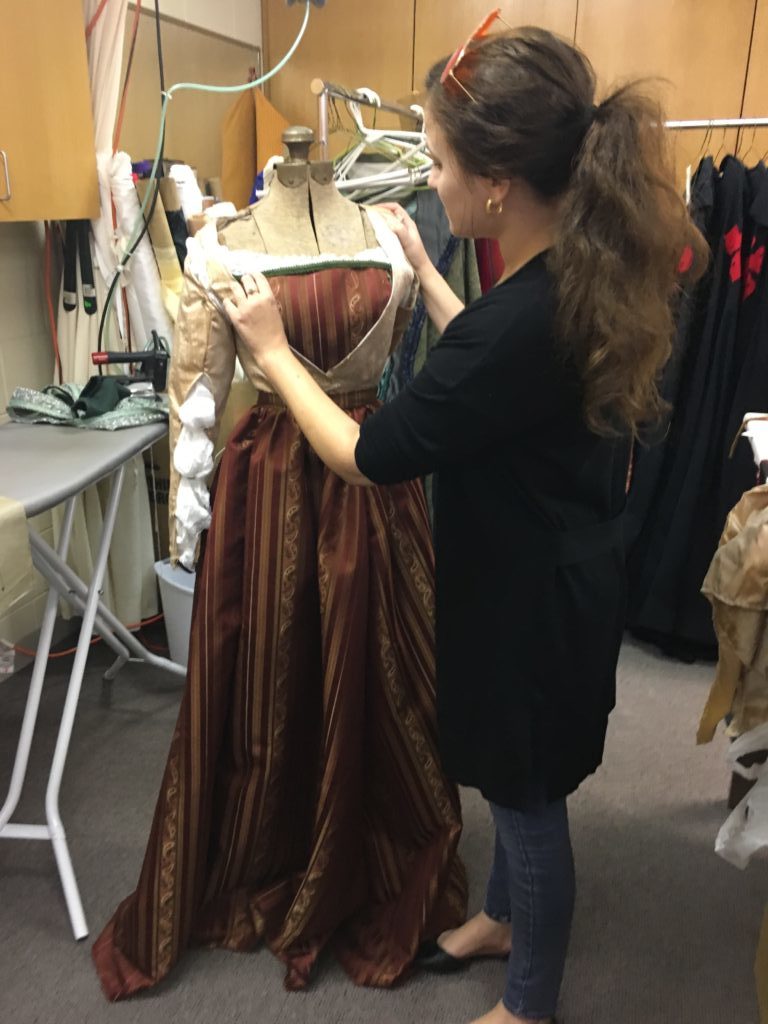
“I am trying to capture the essence of a person in a costume,” she said.
Though Langford appears precisely at home in the basement of the Fine Arts Building, her position there is recent. Hillsdale’s Department of Theatre and Dance hired Langford as costume designer this semester to fill the hole left by Bryan Simmons, who retired to Arizona after 17 years of designing for the college’s theatre productions.
Langford speaks with passion about her role in the theatrical process.
“The goal of the costume designer is to let the audience know who that character is before they even open their mouth on stage. It’s not just throwing something on somebody,” Langford said. “As people, we choose things for certain reasons. Maybe it makes us feel good about ourselves, maybe it has a certain style. As a costume designer, I get to do that for characters and concepts and try to convey those things. It is fun to come up with how to say those things about a character without actually saying them.”
Langford has a strong background in research design and a penchant for pastels. Her early love for drawing and theatre led her to pursue a masters’ of design from the University of Memphis. After graduating she stayed in the area, designing for small shows, operas, and any other opportunity presented to her.
A breakthrough moment in her young career, in which she first discovered her own designs to be “real impressive,” was when she costumed a production of Moliere’s “Learned Ladies.”
“I had to make big Rococo gowns for it, so like 18th century, pastel colors, giant gowns, and that was a complete draping project,” Langford said, referring to the process of arranging each piece of fabric by hand to create the voluminous skirts of the period. “No patterns existed; the patterns were made based on the measurements. That was the first time I made something that big and that serious, and I thought it came out really well.”
James Brandon, chairman of theatre and dance, said that he is excited to welcome Langford to the theater team after a rigorous application process, both because of her skills with the needle and her fresh vision. After working with Simmons for the last 17 years, Brandon said, it will be both reinvigorating and challenging to learn how to communicate and work with a new designer.
Brandon also said Langford has a lot of power to influence the design process.
“In a professional costume shop, you have designers, you have drapers, people working on stitching, people specializing in wigs, and people specializing in hats, and some have costume designers that are good at French neoclassical, and some that are really good at stylized drama,” Brandon said. “Here, Corinne has to do all of that. She is the one voice.”
With that responsibility comes certain limitations. Naturally a perfectionist, Langford prefers to craft each costume from scratch, but with little staff or time, that is impossible.
“If I have six months to do a show, I can make everything myself, and it would be perfect and beautiful and everything I wanted,” Langford said. “But if I have a month to do it then I have to use a couple things from stock and really make it count for the main characters.”
Langford admitted to watching most of her shows for the first time with an eye to what she could have done if she had more time and help.
One of her few assistants, Lilian Schmitz, a senior pursuing a career in ballet design, said she wants to learn as much as she can from Langford before graduating.
“Corinne has an incredibly calming effect on the costume shop. As the season picks up, things can get hectic with the work and sewing piling up,” Schmitz said, “But with my limited experience working with Corinne so far, she’s pretty laid back while at the same time staying on top of everything and ensuring that things are done at a high level of excellence.”
Though her job is inherently creative, Langford has developed a practical process to accomplish a lot with only a little bit of time and help.
She begins her design process with music, creating a playlist for each show or character that inspires her to connect with the emotions, colors, and textures that she wants to incorporate into the costume. Langford admits that it’s “a little weird,” but that the process helps her commune with her inner genius.
From there, she creates a Pinterest board with applicable images, winnowing them down until she develops a clear image of the costume.
Then comes her favorite part: rendering.
“Now renderings I have down to a science,” Langford said. “I can do a rendering in an hour from start to finish. That includes coming up with the ideas and sitting down and actually drawing it. But that is just because I have been doing it forever.”
Finally, she builds the costume. An entire period dress with a skirt, overskirt, corset, and slash and puff sleeves — like the one she designed for Narissa in Tower Player’s production of “Merchant of Venice” — is a simple days work for Langford.
As difficult as it is to meet her own high expectations, Langford said that she still appreciates sitting in a dark theater to enjoy the final product.
“I enjoy seeing how if we work really well together collaboratively, then everything is going to tie in together,” she said.

